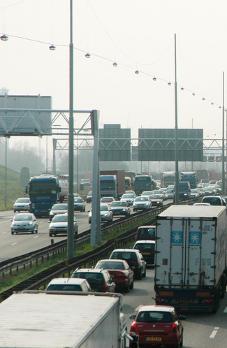Transumo A15 project: Working with uncertainties
| Function / Domain: | Mobility (transport) |
| Illustration of: | Working with uncertainties |
The Dutch project A-15 Van Maasvlakte tot achterland explored possibilities for a sustainable improvement in the connection between the hinterland and the Port of Rotterdam, The problem was that the anticipated growth of the transport (including freight) on the A15 motorway - among other things due to the expansion of the Rotterdam Harbour - would be accompanied by breaches of the standards for air and noise pollution and external security. It would also place a heavy burden on scarce space in neighbouring residential areas, since new houses and business premises would have to be built further from the road. Widening of the A15, as planned, would not provide an adequate and sustainable solution for these problems. The aim of the project was to produce a package of innovative solutions that was technically, politically and procedurally viable.
Uncertainties
The project was surrounded by numerous uncertainties that affected the need, desirability and feasibility of new measures. The most important were:
- Uncertainty about the growth of container transport. The project was initially based on projected growth to 33 million containers in 2033. But the climate crisis and large fluctuations in fuel prices cast doubt on that forecast. Then there was also the financial and economic crisis, the long-term effects of which are difficult to predict.
- Uncertainty surrounding policy. There was uncertainty about whether planned measures arising from the environmental impact report for the Second Maasvlakte would be carried out in time.
- Uncertainty about urgency. Uncertainty about the (local) sense of urgency of alterations to make transport more sustainable seemed to be growing at the start of the project, but naturally the situation could change if other issues appeared on the public agenda and affected the ambitions for sustainability and (local) measures or projects.
Explaining uncertainties and making choices with stakeholder
The project managers dealt with the uncertainties in different ways. To start with, they explicitly identified them and made important choices with regard to them in consultation with the stakeholders.
Monitoring and adjustment
The project managers also monitored significant uncertain developments. This proved useful, since the policy agenda and the ambitions did indeed change in the course of the project. For example, a relvant project, called Mainportcorridor Zuid, was halted prematurely and road pricing was brought closer to reality with a government decision entitled ‘Anders betalen for mobiliteit' [Paying differently for mobility]. The project was revised several times in response to these and other new developments.
Using scenarios
Last but not least, the project managers decided to use scenarios to identify the potential effects of uncertainties. The basic scenario for 2033 was based on the points of departure of the Environmental Impact Report for the construction of the Second Maasvlakte (the preferred alternative). A second scenario was a variant of the preferred alternative. The third scenario was similar to the first one, but included the 3D package of measures (durable, dynamic and daring). Finally, the fourth scenario was based on the second scenario, plus a slightly modified 3D package. This revised package excluded the (uncertain) construction of the Oranje tunnel and the (uncertain) effects of road pricing for private motorists were estimated less optimistically.
The effects of the scenarios were calculated in terms of traffic, air quality, noise and external security. Those effects were then also evaluated for ambitious and less ambitious legal targets for sustainability. In this way the project group was able to show the ultimate influence of a number of uncertain developments on the ultimate effects.
Sources
